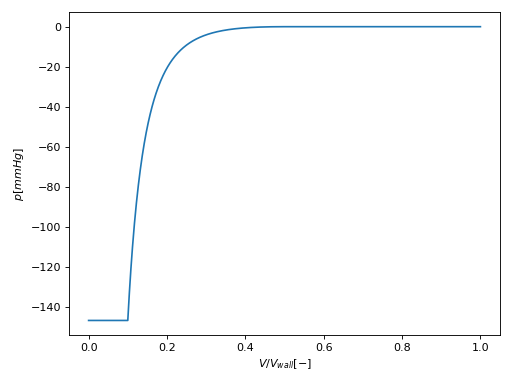Chamber
Module summary
Chamber is a thick-walled sphere with a Wall describing the pressure \(p=f(A_m, C_m)\).
Parameters
- buckling: bool
Buckling function. If True, wall tension cannot be below zero.
Signals
- V [m 3]: array
Volume of the Cavity
- p [Pa]: array
Pressure in the Node
Background
The one-fiber model Arts et al.[1] simulates a pressurized cavity encapsulated by a wall composed of fibers, immersed in a soft incompressible material. Within the CircAdapt framework, the one-fiber model is calculated on the mid-wall of the Wall object. The Chamber module translates its state variable \(V\) (cavity volume) into the regional variable \(A_m\) (mid-wall area).
Module description
The Chamber is implemented as a Cavity, meaning that the pressure is given by
in which the external pressure \(p_{extern}\) comes from the (optional) surrounding cavity and the transmural pressure \(p_{trans}\) is calculated by the \(Wall\) module. The wave impedance \(Z\) is based on Wall properties and defined by
Wave impedance
Todo
derive wave impedance.
Anti Collapse
To prevent the Chamber to fully empty, an additional anti-dollapse pressure is added.
This equation behaves as depicted in the figure below.
(Source code, png, hires.png, pdf)

Fig. 3 Additional pressure as function of \(V/V_{wall}\) to prevent collapse.
Old
The one-fiber model [Arts 1991] simulates a pressurized cavity encapsulated by a wall composed of fibers, immersed in a soft incompressible material. Below, the model is presented briefly. The major assumption is that mechanical energy generated by myofibers dE_f is converted into pump function of the cavity dE_v. without any loss of energy. We define wall shell volume \(Vsh\), myofiber stress \(\sigma_f\), natural myofiber strain \(\epsilon_f\), cavity pressure p and midwall enclosed volume \(V_m\). It holds:
Considering Vsh to be small relative to Vm,, a relative change in fiber strain equals one-third of the relative change in volume, resulting in:
Combining the latter two equations, fiber stress is coupled to cavity pressure:
To accommodate inhomogeneity of mechanical properties in the wall, we modified our approach by inserting Patch-modules, forming together a wall. Linearized mechanical properties of the wall composed of patches are described with a given zero tension mid-wall area \(A_{m,0}\) and wall stiffness \(dT_m/dA_m\). For wall tension T it is found:
In this equation, A_{m,0} and frac{dt}{dA_m} are calculated using the Wall component. At low tension, myocardial fibers may buckle. This model has the option ‘buckling’, which replaces this equation with
The Chamber and TriSeg-module are designed to render cavity pressure(s) as a function of cavity volume(s), given zero-tension area \(A_{m,0}\) and wall stiffness \(dT_m/dAm\).
A chamber consists of a cavity with cavity volume Vc, wall volume Vw, zero tension midwall area \(A_{m,0}\) and wall stiffness \(dT_m/dA_m\). For the primary derivation we use the assumption that the mid-wall surface is spherical with radius r. Using that the mid-wall surface encloses cavity volume and half wall volume, for mid-wall area Aw it holds:
Using Eq.(.) wall tension T is determined. Wall tension T and pressure pc are related by the following equation:
Using \(A_m=4\pi r^2\) and \(V_m=4\pi r^3 / 3\), Eq. (7) renders cavity pressure \(p_c\):
Since pressure \(p_c\) is written as a function of \(V_c\) and \(V_w\), just like with the one-fiber model, the thus calculated pressure is likely to be not very sensitive to differences in geometry, i.e., geometry may differ from spherical.
References
|
Chamber is a thick-walled sphere with a Wall describing the pressure \(p=f(A_m, C_m)\). |